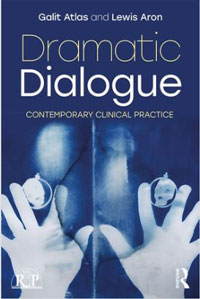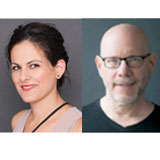Interview by Christina Emanuel (USA)
 Galit Atlas (USA) and Lewis Aron (USA) have recently published their new book, Dramatic Dialogue: Contemporary Clinical Practice (Routledge, 2018) in which they develop the metaphors of drama and theatre to introduce a new way of thinking about therapeutic action and therapeutic traction. They generously agreed to share some thoughts about their new book with the IARPP community in this interview.
Galit Atlas (USA) and Lewis Aron (USA) have recently published their new book, Dramatic Dialogue: Contemporary Clinical Practice (Routledge, 2018) in which they develop the metaphors of drama and theatre to introduce a new way of thinking about therapeutic action and therapeutic traction. They generously agreed to share some thoughts about their new book with the IARPP community in this interview.
Christina Emanuel: Thank you, Galit and Lew, for your willingness to participate in this interview for the IARPP Bookshelf and eNews, and congratulations on the publication of your new book! You state that Dramatic Dialogue “emerged from the playful exchange between two voices, sometimes merged as one, and at other times distinctly different while remaining together in dialogue” (p. 1). Indeed your individual voices – familiar to IARPP members who have read your many publications – shine through, although in this book you seem to have achieved a distinctive literary thirdness, reflecting your collaboration as co-authors. What has it been like to collaborate with one another on this beautiful writing project?
Galit Atlas: Lew and I have very different sensibilities and so it was exciting for us to work together and complement each other. After each chapter that we finished we sat and read the text out loud to each other, and tried to listen to it carefully, somewhat in the way we listen to our patients in analysis. We read it critically, we laughed, sometimes we were moved or got annoyed, and all those feelings exist in the text itself.
Lew Aron: Galit identifies as a writer. She has written her whole life and is very involved in the craft of writing, the style, sound, rhythm of the prose. I think of myself as a teacher and scholar interested in the history of the transmission of ideas from one theorist to the next and across generations and geographies of analysis. We are both interested in communicating clearly to our readers and in this book from the start we wanted to write in a way that would be lucid and smooth.
CE: In your book you draw from Ferenczi, Jung, Ferro, Bion, McDougall, Searles, Mitchell, and so many others as you share your theoretical and clinical concepts. What do you hope readers will take away as the central message of Dramatic Dialogue?
LA: We are trying to highlight a model of therapeutic action that we think crosses traditions and theories and schools. We draw on this wide range of analysts to make the point that dramatization and an affirmative or generative approach to enactment has been developed and utilized across schools and is a way of bringing together diverse approaches even while appreciating and learning from their differences. It is a model of therapeutic action rather than a prescription for a particular technique or form of intervention, although we believe that the model offers lessons for gaining therapeutic traction.
GA: One thing that we felt was necessary was to create a highly clinical book with many clinical tales and which not only spells out history and theory but always brings it back into the analytic consulting room. Therefore, along with the many schools and theorists are also many demonstrations of clinical material, some our own and some from the literature.
CE: One of your main points is that expanding the scope and practice of psychoanalysis from being just a talking cure to including an affirmative stance toward enactment and dramatic dialogue requires adjustments to our theory of therapeutic action. To what extent do you find that contemporary psychoanalysis retains a narrow focus that resists enactment? My impression is that, at least in our IARPP community, we are already quite friendly to such concepts.
GA: We agree that in contemporary psychoanalysis, and especially in relational circles, enactment is a very common term, and, in the book, we refer to the history and development of that concept. Traditionally the way we think of the value of enactment emphasizes “catching” it or getting out of it. Our approach emphasizes the generative use of enactment which we relate to Jung’s “prospective function,” a perspective that integrates the past, the present, but also the future.
LA: One of the hallmarks of our book is that we take an affirmative approach to enactment, which does not mean that all enactment is productive, but rather that enactments have the potential to lead us somewhere useful if they can be engaged with and developed constructively; this is to say, enactments have a leading edge. Interpretation continues to play a role in this approach, but they serve to deepen the dramatic dialogue rather than only to translate or explicate.
CE: Dramatic Dialogue offers numerous experience-near and engaging clinical tales to illustrate its concepts. I feel that such clinical narrative is a sine qua non of our relational literature and is a critically important part of how we learn. Separately from the challenges that come with the territory—such as with confidentiality or the potential for exploitation—and about which you have written and presented recently, I’m wondering what recommendations you might have for those of us interested in clinical writing. That is, what do you think makes for the most compelling and useful clinical tales?
GA: Personally, I’ll say, for me, good clinical description resonates with the analyst’s emotional truth. When I write a case what I try to capture, while disguising the patient and changing details, is not a procedural or literal description, but something that feels real and touches me emotionally. In some ways that makes the clinical writing harder because it becomes a real emotional journey, where we meet ourselves, our own good and bad objects, the parts of the patient that live inside of us, and our own pain. The enactment exists in the text itself and we invite the reader to live something through with us. When we read our clinical material out loud, we were constantly asking ourselves what it was that we felt, sometimes something made us cry or feel anxious and in other cases we just could not stop laughing.
CE: Openness to enactment and dramatic dialogue, as you describe it in your book, suggests a particular analytic stance and mindset, including openness to mystery and a willingness to trust oneself. By way of example, you discuss Stephen Mitchell’s clinical “outbursts,” moments in which he would share certain personal reactions when, for example, feeling stuck in an unacceptable binary position with a patient.
In contrast, you also describe Corbett’s call to maintain a space for privacy and self-care in the midst of clinical mutuality. I’m wondering if you could share your thoughts about the relationship between clinical engagement and privacy. I ask because enactment and clinical mutuality make for great clinical writing, but sometimes I wonder if clinicians sometimes get the wrong idea about their relative importance.
GA: It is especially important to emphasize that the book’s title, dramatic dialogue, is not meant to encourage any dramatic encounter or active interaction with the patient, in fact to the contrary, this listening and playing with our patients necessarily requires discipline, boundaries, and structure. We are describing a way of listening to the inevitable drama that always exists unconsciously.
LA: It’s great that you refer here to Mitchell’s “clinical outbursts” which we discuss as an illustration or style of dramatic dialogue. In carefully studying his clinical vignettes, several decades after he wrote them, one is struck by just how “tame” and contained they feel in today’s clinical climate, following several decades of work emphasizing enactment. Greenberg was among the first to caution the relational community about the excesses of their clinical vignettes, and throughout the book we emphasize the dialectics of restraint and expressiveness, discipline and improvisation.
CE: What other projects and activities—professional, creative, or otherwise—are you working on these days?
LA: One of my current projects is a direct extension of your last question and our previous remarks, namely, together with Sue Grand and Joyce Slochower, I edited two new books about exactly this theme. De-idealizing Relational Theory: A Critique from Within (Routledge, 2018), and Decentering Relational Theory: A Comparative Critique (Routledge, 2018). These collections include many of our most prominent relational writers addressing, in a variety of ways, the tensions and contradictions that we are discussing. I’m writing several other papers and hope to pull together another book of my clinical writings, and of course Galit and I are now busy teaching and doing clinical workshops on Dramatic Dialogue. Galit is already immersed in her next book, the details of which I am not allowed to reveal.
CE: Thank you, Lew and Galit, for taking the time to respond to these questions and introduce your book to our international psychoanalytic community.
Link to Publisher: https://www.routledge.com/Dramatic-Dialogue-Contemporary-Clinical-Practice/Atlas-Aron/p/book/9781138555488
 Galit Atlas, PhD
Galit Atlas, PhD
USA
Email Galit Atlas
Website: www.galitatlas.com
 Lewis Aron, PhD
Lewis Aron, PhD
Director, NYU Postdoctoral Program in Psychotherapy & Psychoanalysis
240 Greene Street, Third Floor
New York, NY 10003. USA
Email Lewis Aaron


